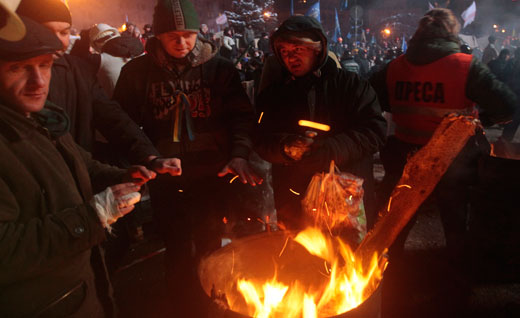
For more than two weeks, Ukraine (population 46 million) and its capital, Kiev have been the site of large-scale demonstrations against the government of President Victor Yanukovych.
A little background:
Before the Russian Revolution, Ukraine was fought over among the Russian, Polish-Lithuanian and Ottoman Turkish empires. By the 19th century, most of it was part of the empire of the czars. It was, and is, economically important because of its vast grain production and also its subsoil resources. It became an important republic in the Soviet Union, under which Ukraine also developed significant heavy industry.
Under Soviet rule, Ukraine initially thrived. However, in the 1930s, the attempt by Stalin’s government at forced collectivization, and the suppression of Ukrainian cultural figures during the purges, caused much death and suffering.
Ukraine has always had to deal with a division between its more conservative West and its East, which has strong ties to Russia. The German invasion during the Second World War led some in the western Ukraine to collaborate with the Nazis who were slaughtering Jews, Roma and communists. As the war drew to the close, a right wing independence movement was led by Ukrainian nationalist Stepan Bandera. Bandera’s movement was anti-Russian, anti-communist, anti-Semitic and anti-Polish, and carried out terrorist acts until it was crushed.
Nevertheless, Bandera today is honored with statues and other monuments in some places in the Ukraine.
Ukraine became an Independent republic in 1991 when the Soviet Union collapsed. This was followed by a sharp economic decline, which has only partly been corrected. The Communist Party is still fairly strong, and the eastern part of the country, with its many ethnic Russians, still tends to look eastward and emphasize relations with Russia. Ukraine’s leaders have attempted a balancing act between Russian and Western European influences, with internal reverberations.
The current problems began when Yanukovych suspended negotiations for an association with the European Union (EU). Western politicians and media put out the word that Russia had pressured Ukraine to distance itself from the EU, but the deal being offered to the Ukraine had serious drawbacks to a country with a per capita gross domestic product of only $7,442. The deal would entail accepting neoliberal policies of “free” trade and austerity that have brought about massive suffering and protests in EU countries such as Portugal, Spain and Greece, and has also led to German economic dominance. Existing trade relations with Russia, which provides most of Ukraine’s oil and natural gas, might have been disrupted. There was also fear that the EU association might bring Ukraine into NATO, which Russia could not tolerate.
In the protests against the suspension of the negotiations with the EU, it is mostly right-wing and anti-Russian groups who are the prime movers, as well as major business leaders.
One major influence is the Svoboda (Freedom) Party headed by Oleh Tyahnybok, a parliamentarian from the western city of Lviv, which is a hotbed of right-wing nationalist activity. Svoboda is a rising far-right outfit, similar to Hungary’s Jobbik and France’s National Front. Tyahnbok is a Bandera admirer given to using crude anti-Semitic language. Ironically, like most of the ultra-right that has been rising in Europe, Tyahnybok is rabidly nationalistic and anti-European Union; his main reason pushing the demonstrations has been anti-Russianism.
Another influential politician in the mix is champion heavyweight boxer Vitaly Klitschko, a leader of the appropriately nicknamed “Punch” Party (Ukrainian Democratic Alliance for Reform). Klitschko favors the entry of Ukraine both into the European Union and into NATO. Other than that, his program involves cleaning up political corruption.
A third influential force is the All Ukrainian “Fatherland” Party of former Prime Minister Iulia Tymoshenko, who is currently serving a jail term for abuse of power. Ironically, the abuse charge against her alleged that she had been rather too pro-Russian in trade negotiations with the Russian natural gas company Gazprom. Her defenders say she merely acceded to reality in a situation, in 2009, in which Vladimir Putin had shut off fuel supplies to the Ukraine as a pressure tactic.
So the demonstrators in Kiev and elsewhere don’t have one coherent program of demands, and the main thing that holds them together is anti-Russianism, and an admiration for the “civilized” West. To express this, on Sunday they knocked down a large statue of V.I. Lenin in downtown Kiev, and have threatened the headquarters of the Communist Party of the Ukraine, which is not part of the government.
The Communist Party of the Ukraine warns that a fascist coup might be in the works. Petro Semonyenko, first secretary of the Central Committee of the Communist Party, said in a statement that his party calls for a referendum on the European Union issue, but also sharply criticizes President Yanukovych for autocratic practices, for setting the stage for the current crisis by promoting European Union membership while also flirting with far-right, anti-Russian groups that have now turned against him.
At writing, protesters, backed by Western politicians, have rejected the offer of talks by the government, which they want removed. On Tuesday evening, there were clashes between protesters and police trying to clear a main square in Kiev.
Photo: Pro-European Union activists warm themselves around a bonfire as they gather in Independence Square in Kiev, Ukraine, Wednesday, Dec. 11, 2013. Police in Ukraine on Wednesday pulled back as protesters claimed victory after an overnight face-off in which authorities removed some barricades and tents and scuffled with demonstrators occupying Kiev’s main square.
Photo: AP/Sergei Chuzavkov










